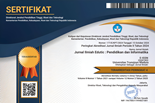SISTEM PELAYANAN KESEHATAN TERPADU BERBASIS IOT PADA FASILITAS KESEHATAN
Abstract
Pelayanan kesehatan merupakan salah satu masalah terpenting dalam kehidupan manusia. Ilmu komputer, jaringan, teknik elektro dan informatika mampu mengubah proses pelayanan kesehatan. Teknologi Informasi pada bidang Kesehatan menjadi fokus banyak penelitian saat ini. Kebutuhan terhadap IT semakin meningkat di bidang kesehatan. Informasi kesehatan terdiri dari informasi terkait tindakan medis atau administratif yang dicatat dalam bentuk apapun, yang dibuat atau diterima oleh penyedia layanan kesehatan. Berdasarkan uraian diatas, maka penulis merancang sebuah sistem pelayanan kesehatan terpadu mulai yang sesuai dengan Standard Operation Prosedure (SOP) pada fasilitas kesehatan pemerintah mulai dari masuknya pasien hingga keluarnya pasien yang terintegrasi pada setiap prosesnya menggunakan internet dan peralatan pendukung yang sesuai. Sistem pelayan terpadu pada fasilitas kesehatan memiliki 4 modul yang dikembangakan secara bertahap menggunakan metode feature driven development. Terdapat banyak manfaat jika sistem pelayanan terpadu berbasis IoT ini diterapkan di fasilitas kesehatan.
Full Text:
PDFReferences
Abdul K. N. S. and Ahmad M., (2010), An overview of electronic health record (EHR) implementation framework and impact on health care organizations in malaysia: A case study, 2010 IEEE Int. Conf. Manag. Innov. Technol., pp. 84– 89.
Al Fatta, H. (2007). Analisis & Perancangan Sistem Informasi. ANDI: Yogyakarta
Ayatollahi H., Roozbehi M., and Haghani H., (2015). Physicians’ and Nurses’ Opinions about the Impact of a Computerized Provider Ord er Entry Sistem on Their Workflow., Perspective.in Health Information. Management., vol. 12, retrieved from https://www.ncbi.nlm.nih.gov/pmc/articles/PMC4632876/
Aziz N. F. Ab. and Mohamadali N. A., (2015). “The challenges of human factors for implementation of information sistems in the health care,”ARPN Journal of Engineering and Applied Sciences , vol. 10, no. 23, pp. 17914–17922,
Bialy T., KobusinskiJ., MaleckiM., StefaniakK., Emeh: (2011). Extensible mobile platform for healthcare, in: Computer Science and Information Sistems (FedCSIS), Federated Conference on, IEEE, 2011, pp. 355–361.
Burney SMA, Mahmood N, Abbas Z. (2010). Information and Communication Technology in Healthcare Management Sistems: Prospects for Developing Countries. Int. J. Comput. Appl.4(2):27-32. doi:10.5120/801-1138.
Cresswell K. and Sheikh A. (2015), Health information technology in hospitals: current issues and future trends,” Future Hospital Journal, vol 2, no. 1, pp. 50-56
Darwish A., Hassanien A. E. (2011), Wearable and implantable wireless sensor network solutions for healthcare monitoring, Sensor 11 (6) pp. 5561–5595.
European Commission. (2008). Internet of things in 2020 road map for the future (Working Group RFID of the ETP, EPOSS,Tech. Rep.). Retrieved 20110612 from: http://ec.europa.eu/information_society/policy/rfid/documents/iotprague2009.pdf
Fadhil N., Jusop M., and Abdullah A. (2012), “Hospital Information Sistem (His) Implementation In A Public Hospital: A Case Study F rom Malaysia,” Far East Journal of Pshycology and Business vol. 8 No. 3.,
Vermesan, Ovidiu & Friess, Peter & Guillemin, Patrick & Gusmeroli, Sergio & Sundmaeker, Harald & Bassi, Alessandro & Soler Jubert, Ignacio & Mazura, Margaretha & Harrison, Mark & Eisenhauer,
Markus & Doody, Pat. (2009). Internet of Things Strategic Research Roadmap. Retrieved 20110612 from https://www.researchgate.net/publication/267566519_Internet_of_Things_Strategic_Research_Roadmap
Guo B., Zhang D., & Wang Z. (2011). Living with Internet of Things: The Emergence of Embedded Intelligence. In Proceedings of the Fourth International Conference on Cyber, Physical and Social Computing (CPSCom), Dalian, China, October 19-22 (pp.297–304).
H. Ayatollahi H, N. Mirani N., and H. Haghani H., (2014),“Electronic Health Records: What Are the Most Important Barriers?,” Perspective in. Health Information. Management., pp. 1–12,
Kadry B., Sanderson I.C., and Macario A., (2010), Challenges that limit meaningful use of health information technology Current Opinion in Anaesthesiology, vol. 23, no. 2, pp. 184–192,
Khalifa M. and Alswailem O., (2015),“Hospital Information Sistems (HIS) Acceptance and Satisfaction: A Case Study of a Tertiary Care Hospital,” Procedia - Procedia Computer. Science., vol. 63, pp. 198–204,
Lu, T., & Neng, W. (2010). Future internet: The internet of things. In Proceedings of the3rd International Conference on Advanced Computer Theory and Engineering (ICACTE) (Vol. 5,pp. (376-380). doi:10.1109/ICACTE.2010.5579543,
Palmer, S.R., & Felsing, J.M. (2002). A Practical Guide to Feature-Driven Development. Prentice Hall. (ISBN 0-13-067615-2)
Peraturan Pemerintah Republik Indonesia Nomor 47 Tahun 2016, (2016) Tentang Fasilitas Pelayanan Kesehatan,
Pereiraa A., Marinsa F., Rodriguesa B., Portelaa F., Filipe M., Santosa, Machadoa J., Ruab F., Silvab Á., & Abelhaa A., (2015), Improving Quality of Medical Service with Mobile Health Software, in: Procedia Computer Science 63 pp 292 – 299,
Pressman, R. (2010). Software engineering: a practitioner’s approach 7th ed., Mc Graw Hill: New York.
Rashid Z., Farooq U., Jang J.K., Park S.H., (2011), Cloud computing aware ubiquitous health care system, in: E-Health and Bioengi-neering Conference (EHB), IEEE, 2011, pp. 1–4.
Vermesen, O., & Friess, P. (2014). Internet of Things: From Research and Innovation to Market Deployment. River Publishers.
Wager K. A, Lee F. W., and Glaser J. P., (2010) Managing Health Care Information Sistems: A Practical Approach for Health Care Executives:John Wiley & Sons.
DOI: https://doi.org/10.21107/edutic.v5i1.4381
Refbacks
- There are currently no refbacks.
Copyright (c) 2018 Agung Nugroho Pramudhita, Abdul Muhsyi, Mungki Astiningrum

This work is licensed under a Creative Commons Attribution 4.0 International License.
Indexed by:
 J. Ilm. Edutic is licensed under a Creative Commons Attribution 4.0 International License.
J. Ilm. Edutic is licensed under a Creative Commons Attribution 4.0 International License.















